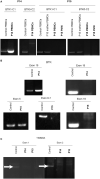Distinct Clinical Features and Novel Mutations in Taiwanese Patients With X-Linked Agammaglobulinemia
- PMID: 33013854
- PMCID: PMC7498534
- DOI: 10.3389/fimmu.2020.02001
Distinct Clinical Features and Novel Mutations in Taiwanese Patients With X-Linked Agammaglobulinemia
Abstract
Background: X-linked agammaglobulinemia (XLA) is caused by a mutation of the Bruton's tyrosine kinase (BTK) gene and is the most common genetic mutation in patients with congenital agammaglobulinemia. The aim of this study was to analyze the clinical features, genetic defects, and/or BTK expression in patients suspected of having XLA who were referred from the Taiwan Foundation of Rare Disorders (TFRD). Methods: Patients with recurrent bacterial infections in the first 2 years of life, serum IgG/A/M below 2 standard deviations of the normal range, and ≦2% CD19+B cells were enrolled during the period of 2004-2019. The frequency of infections, pathogens, B-lymphocyte subsets, and family pedigree were recorded. Peripheral blood samples were sent to our institute for BTK expression and genetic analysis. Results: Nineteen (from 16 families) out of 29 patients had BTK mutations, including 7 missense mutations, 7 splicing mutations, 1 nonsense mutation, 2 huge deletions, and 2 nucleotide deletions. Six novel mutations were detected: c.504G>T [p.K168N], c.895-2A>G [p.Del K290 fs 23*], c.910T>G [p.F304V], c.1132T>C [p.T334H], c.1562A>T [p.D521V], and c.1957delG [Del p.D653 fs plus 45 a.a.]. All patients with BTK mutations had obviously decreased BTK expressions. Pseudomonas sepsis developed in 14 patients and led to both Shanghai fever and recurrent hemophagocytic lymphohistiocytosis (HLH). Recurrent sinopulmonary infections and bronchiectasis occurred in 11 patients. One patient died of pseudomonas sepsis and another died of hepatocellular carcinoma before receiving optimal treatment. Two patients with contiguous gene deletion syndrome (CGS) encompassing the TIMM8A/DDP1 gene presented with early-onset progressive post-lingual sensorineural Deafness, gradual Dystonia, and Optic Neuronopathy syndrome (DDON) or Mohr-Tranebjaerg syndrome (MTS). Conclusion: Pseudomonas sepsis was more common (74%) than recurrent sinopulmonary infections in Taiwanese XLA patients, and related to Shanghai fever and recurrent HLH, both of which were prevented by regular immunoglobulin infusions. Approximately 10% of patients belonged to CGS involving the TIMM8A/DDP1 gene and presented with the DDON/MTS phenotype in need of aggressive psychomotor therapy.
Keywords: Bruton's tyrosine kinase (BTK); Mohr-Tranebjaerg syndrome (MTS); TIMM8A/DDP1 gene; X-linked agammaglobulinemia (XLA); contiguous gene deletion syndrome (CGS); deafness-dystonia-optic neuronopathy syndrome (DDON).
Copyright © 2020 Yeh, Hsieh, Lee, Huang, Chen, Yeh, Ou, Yao, Wu and Lin.
Figures



Similar articles
-
Clinical characteristics and prenatal diagnosis for 22 families in Henan Province of China with X-linked agammaglobulinemia (XLA) related to Bruton's tyrosine kinase (BTK) gene mutations.BMC Med Genet. 2020 Jun 17;21(1):131. doi: 10.1186/s12881-020-01063-5. BMC Med Genet. 2020. PMID: 32552675 Free PMC article.
-
Clinical and genetic profiles of patients with X-linked agammaglobulinemia from southeast Turkey: Novel mutations in BTK gene.Allergol Immunopathol (Madr). 2019 Jan-Feb;47(1):24-31. doi: 10.1016/j.aller.2018.03.004. Epub 2018 Jul 30. Allergol Immunopathol (Madr). 2019. PMID: 30072168
-
A Novel BTK Gene Mutation in a Child With Atypical X-Linked Agammaglobulinemia and Recurrent Hemophagocytosis: A Case Report.Front Immunol. 2019 Aug 20;10:1953. doi: 10.3389/fimmu.2019.01953. eCollection 2019. Front Immunol. 2019. PMID: 31481959 Free PMC article.
-
Splice-correction strategies for treatment of X-linked agammaglobulinemia.Curr Allergy Asthma Rep. 2015 Mar;15(3):510. doi: 10.1007/s11882-014-0510-0. Curr Allergy Asthma Rep. 2015. PMID: 25638286 Free PMC article. Review.
-
Pseudomonas aeruginosa sepsis presenting as oral ecthyma gangrenosum in identical twins with Bruton tyrosine kinase gene mutation: Two case reports and review of the literature.J Microbiol Immunol Infect. 2020 Dec;53(6):1030-1034. doi: 10.1016/j.jmii.2020.04.009. Epub 2020 Apr 17. J Microbiol Immunol Infect. 2020. PMID: 32340921 Review.
Cited by
-
Promising Targeted Therapies for Hemophagocytic Lymphohistiocytosis: A Translational Perspective Based on Immunopathology.Clin Rev Allergy Immunol. 2025 Jun 9;68(1):56. doi: 10.1007/s12016-025-09068-9. Clin Rev Allergy Immunol. 2025. PMID: 40484874 Review.
-
Cancer Trends in Inborn Errors of Immunity: A Systematic Review and Meta-Analysis.J Clin Immunol. 2024 Oct 28;45(1):34. doi: 10.1007/s10875-024-01810-w. J Clin Immunol. 2024. PMID: 39466473
-
Hematopoietic Cells from Pluripotent Stem Cells: Hope and Promise for the Treatment of Inherited Blood Disorders.Cells. 2022 Feb 5;11(3):557. doi: 10.3390/cells11030557. Cells. 2022. PMID: 35159366 Free PMC article. Review.
-
Clinical and Genetic Profile of X-Linked Agammaglobulinemia: A Multicenter Experience From India.Front Immunol. 2021 Jan 15;11:612323. doi: 10.3389/fimmu.2020.612323. eCollection 2020. Front Immunol. 2021. PMID: 33584693 Free PMC article.
-
Prevalence of Ophthalmological Manifestations in Patients with Inborn Errors of Immunity: A Systematic Review and Meta-Analysis.J Clin Immunol. 2025 May 13;45(1):92. doi: 10.1007/s10875-025-01880-4. J Clin Immunol. 2025. PMID: 40358744 Free PMC article.
References
-
- Bruton OC. Agammaglobulinemia. Pediatrics. (1952) 9:722–8. - PubMed
-
- Ohta Y, Haire RN, Litman RT, Fu SM, Nelson RP, Kratz J, et al. . Genomic organization and structure of Bruton agammaglobulinemia tyrosine kinase: localization of mutations associated with varied clinical presentations and course in X chromosome-linked agammaglobulinemia. Proc Natl Acad Sci USA. (1994) 91:9062–6. 10.1073/pnas.91.19.9062 - DOI - PMC - PubMed
-
- Nomura K, Kanegane H, Karasuyama H, Tsukada S, Agematsu K, Murakami G, et al. . Genetic defect in human X-linked agammaglobulinemia impedes amaturational evolution of pro-B cells into a later stage of pre-B cells in the B-cell differentiation pathway. Blood. (2000) 96:610–7. - PubMed
-
- Winkelstein JA, Marino MC, Lederman HM, Jones SM, Sullivan K, Burks AW, et al. . X-linked agammaglobulinemia: report on a United States registry of 201 patients. Medicine. (2006) 85:193–202. 10.1097/01.md.0000229482.27398.ad - DOI - PubMed
Publication types
MeSH terms
Substances
Supplementary concepts
LinkOut - more resources
Full Text Sources
Medical

